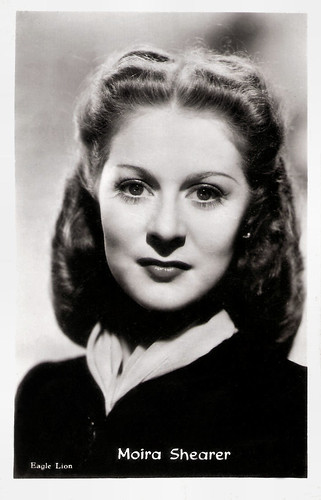
Belgian postcard. Photo: Eagle Lion.
Red-headed Moira Shearer (1926-2006) was a luminous star of British ballet. She became an international film idol with her unforgettable debut as the young ballerina Vicky in The Red Shoes (1948), a classic of British cinema and probably the most popular film about ballet ever.
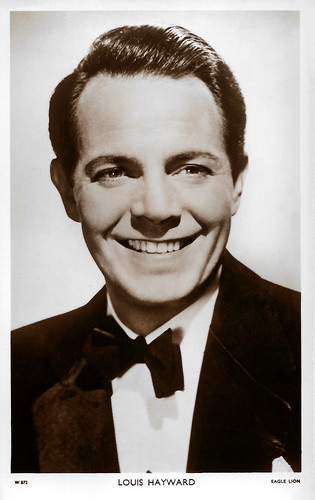
British postcard in the Picturegoer Series, London, no. W. 872. Photo: Eagle Lion.
British-American actor Louis Hayward (1909-1985) was a protégé of Noël Coward and began his career in London in such plays as 'Dracula' and in British films. After appearing on Broadway, he had a long career in Hollywood. Hayward was the first screen incarnation of Simon Templar in Leslie Charteris' The Saint in New York (1938) and had a dual role in The Man in the Iron Mask (1939) under the direction of James Whale. His debonair charm and athletic good looks made him one of Hollywood’s most successful swashbuckling heroes of the 1930s and 1940s.

Dutch card. Photo: Eagle Lion.
Lana Morris (1930-1998) was a stylish and gifted British actress who appeared in films during the late 1940s and 1950s and continued her career on stage and television. She is best known for her two comedies with Norman Wisdom, Trouble in Store (1953) and Man of the Moment (1955).

Dutch autograph card. Photo: Eagle Lion.
British actor David Tomlinson (1917-2000) was both a leading man, a character actor and a comedian. He is best remembered for his roles in the Walt Disney successes Mary Poppins (1964) as authority figure George Banks, The Love Bug (1968) as hapless antagonist Peter Thorndyke, and Bedknobs and Broomsticks (1971) as fraudulent magician Professor Emelius Browne.
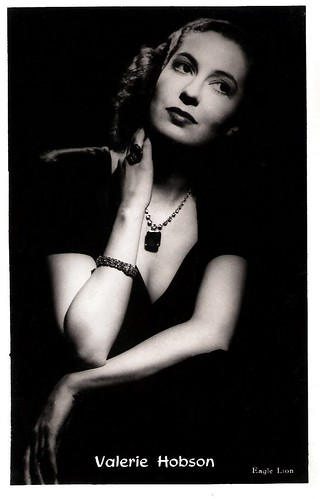
British postcard. Photo: Eagle Lion.
Elegant, redheaded Valerie Hobson (1917-1998) was a great beauty who became an impressive actress. The British actress landed some very choice roles in the later 1940s and was at her best in those films in which she could exercise her comedy talent.
Poverty Row
Pathé Industries' Eagle-Lion Films subsidiary was founded in December 1945. American railway magnate Robert R. Young already owned PRC Pictures, a studio on Hollywood's so-called 'Poverty Row', the companies that mainly made B-movies. Young made a deal with J. Arthur Rank which led to the creation of the distribution company Eagle-Lion Films and the studio Eagle-Lion Studios. From 1946 to 1949, Eagle-Lion was led by Arthur B. Krim. In addition to releasing films by Rank and reissues of David O. Selznick films, it produced its own B-movies. Bryan Foy the former head of the B-picture unit at Warner Bros., was in charge of production.
The initial arrangement was that Rank and Eagle-Lion would each produce five films a year. Costs were initially kept to less than $500,000 per film. Their first year of films was financed with $8 million in loans from the Bank of America which Young personally guaranteed. The company recorded a loss of $2.2 million in 1947. Krim later attributed this to them paying too much money for stars who were scarcely good enough to prevent insufficient box-office returns.
This encouraged Eagle-Lion to change its mode of production, using more independent producers as a source for new films. Bryan Foy resigned as head of production to become an independent producer for the company and Arthur Krim became studio chief. Eagle-Lion would help finance the films and offer facilities, although producers would find their own money too.
Along with Foy, other independent producers who worked for Eagle-Lion included Edward Small, Walter Wanger and George Pal. They began making lower-budgeted films, enjoying particular success with Film Noir. Eagle-Lion had acquired the film studio of Producers Releasing Corporation (PRC), which had acquired the building from the no-longer extant Grand National Pictures. PRC was dissolved in August 1947 and its product was shifted to Eagle-Lion.
By 1947–1948, the studio had completed 14 productions. By the spring of 1949, ten were in release, five of which earned a substantial profit – T-Men, Raw Deal, Canon City, He Walked By Night and The Noose Hangs High. Two others broke even and two others showed losses. If the company had completely financed these films it would have made $1.2 million but as it was it made $200,000. However, because of its unsuccessful first year, the company still owed money and closed its studio in November 1948.
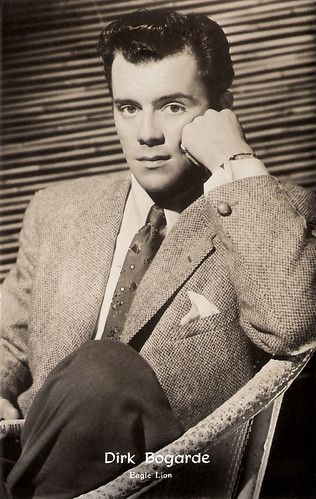
British card. Photo: Eagle Lion.
Distinguished British actor and novelist Sir Dirk Bogarde (1921-1999) was Britain's number one box office draw of the 1950s, gaining the title of ‘The Matinee Idol of the Odeon’. In the 1960s, he abandoned his heart-throb image for more challenging parts in films by Joseph Losey, John Schlesinger, Luchino Visconti, Liliane Cavani and Rainer Werner Fassbinder. Bogarde made a total of 63 films between 1939 and 1991.

Dutch postcard by Hemo. Photo: Eagle Lion.
British entertainer Georgette 'Googie' Withers (1917-2011) had a long career in theatre, film, and television. She was a well-known actress during the war and post-war years. During the 1930s, Withers was constantly in demand for lead roles in minor films and supporting roles in more prestigious productions. Her best-known work of the period was as one of Margaret Lockwood's friends in Alfred Hitchcock's The Lady Vanishes (1938). Among her successes of the 1940s, and a departure from her previous roles, was the Powell and Pressburger film One of Our Aircraft Is Missing (1942), a topical World War II drama in which she played a Dutch resistance fighter who helps British airmen return to safety from behind enemy lines. In 1948 British exhibitors voted her the 8th most popular British star in the country. She is also remembered for her role as the devious Helen Nosseross in the classic Film Noir Night and the City (1950). Googie Withers was a longtime resident of Australia with her husband, the actor John McCallum, with whom she often appeared.
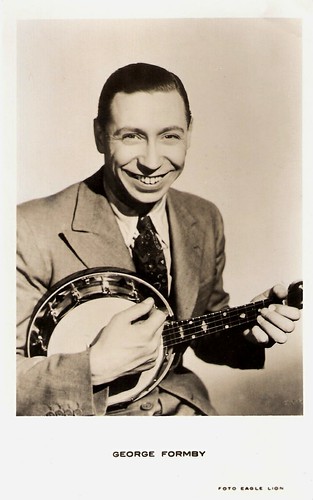
Dutch postcard by Hemo. Photo: Eagle Lion.
George Formby (1904–1961) was Britain's most popular film comedian between 1934 and 1945 and one of the highest-paid stars. He appeared in 21 hit films, cut over 230 records, and entertained an estimated three million Allied Servicemen during World War II. His trademark was the ukulele - along with his buck-toothed grin.
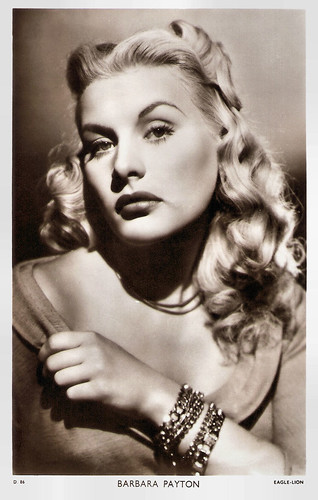
British postcard in the Picturegoer Series, London, no. D 86. Photo: Eagle-Lion.
American film actress Barbara Payton (1927-1967) was a blue-eyed, peroxide-blonde sexpot, less known for her films than for her stormy social life and eventual battles with alcohol and drug addiction. Her tale is one of the saddest ever to come out of Hollywood.

Dutch postcard by HEMO. Photo: Eagle Lion. Publicity still for Caesar and Cleopatra (1945).
The career of English stage and film actor Claude Rains (1889-1967) spanned 47 years. In Hollywood, he was a supporting actor who achieved A-list stardom. With his smooth distinguished voice, he could portray a wide variety of roles, ranging from villains to sympathetic gentlemen. He is best known as the title figure in The Invisible Man (1933), as wicked Prince John in The Adventures of Robin Hood (1938), as a corrupt senator in Mr. Smith Goes to Washington (1939), and, of course, as Captain Renault in Casablanca (1942).
Unsuccessful at the American box office
Eagle-Lion released a series of British films, most of which were unsuccessful at the American box office. There were some exceptions, such as the drama The Red Shoes (Michael Powell, Emeric Pressburger, 1948). It marked the feature film debut of Moira Shearer, an established ballerina, and also features Robert Helpmann, Léonide Massine, and Ludmilla Tchérina, other renowned dancers from the ballet world. The film earned rentals of $5 million and was their only release which was nominated for the Academy Award for Best Picture.
Another success was T-Men (Anthony Mann, 1947), a semidocumentary and police procedural-style Film Noir about United States Treasury agents. The film was shot by noted Noir cameraman John Alton and features Dennis O'Keefe. The company suffered increasing financial difficulties throughout 1949. Arthur Krim resigned in May and the company ceased production at the end of the year. Eagle-Lion merged with Film Classics in 1950 to become Eagle-Lion Classics.
Another interesting film was the American police procedural Film Noir He Walked by Night (Alfred L. Werker, Anthony Mann, 1948), shot in a semidocumentary tone. It was loosely based on the real-life actions of Erwin "Machine-Gun" Walker, played by Richard Basehart, a former Glendale, California police department employee and World War II veteran who unleashed a crime spree of burglaries, robberies and shootouts in the Los Angeles area in 1945 and 1946. Assistant director Reggie Callow felt that the studio would have survived longer had they kept producing this kind of low-budget films rather than attempting to compete with the major studios by making higher-budgeted films.
When PRC shut down in 1948, its distribution exchanges were assumed by Eagle-Lion Films. In 1950, Pathé merged Eagle-Lion with an independent reissue distributor, Film Classics, to create Eagle-Lion Classics. The latter was acquired by and merged into United Artists a year later. Rank also released films in the United Kingdom through Eagle-Lion Distributors Limited.
In 1951, Arthur Krim was offered the leadership of United Artists. In April of that year, UA took over the distribution of Eagle-Lion's current releases. Eagle-Lion terminated the release pact with Rank and ceased distributing films. Their studios were sold. In 1954, Frederick Ziv bought Eagle-Lion for the production of his syndicated Ziv television programme. Its relatively small studio was located at 7950 Santa Monica Boulevard, Hollywood, and has since been demolished.

Dutch postcard. Photo: Eagle Lion.
British actress Sandra Dorne (1924-1992) was a sexy and glamorous bombshell. She was a popular pin-up early in her career, played leads in the 1950s and later appeared in supporting roles.

Dutch postcard by HEMO. Photo: Eagle Lion.
British Academy Award-winning actor David Niven (1910-1983) impersonated the archetypal English gentleman, witty, naturally charming, and immaculate in dress and behaviour, but he also had a dash of light-hearted sexual roguishness. He is probably best known for his role as the punctuality-obsessed adventurer Phileas Fogg in Around the World in 80 Days (1956).

Dutch postcard by Hemo. Photo: Eagle Lion.
Jean Kent (1921-2013) was a strawberry-blonde British actress who played spiteful hussies or femmes fatales in British films of the 1940s and 1950s.

Dutch postcard. Photo: Eagle Lion.
English film, stage and television actor Trevor Howard (1913-1988) is best known as the doctor in the classic romantic drama Brief Encounter (David Lean, 1945), in which his co-star was Celia Johnson. In the 1940s and 1950s, he often played the slightly dry, slightly crusty but capable British military officer, and in the 1960s he became one of England's finest character actors.
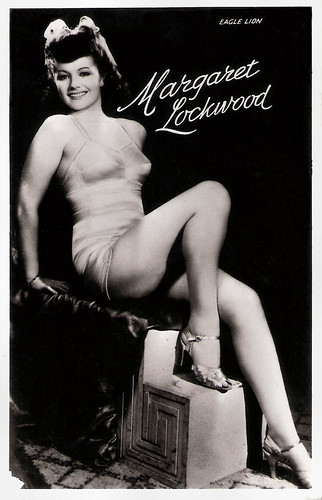
Dutch postcard by Uitgeverij Takken, Utrecht, no. 3239. Photo: Eagle Lion.
Beautiful stage and film actress Margaret Lockwood (1916-1990) was the female lead of the early Hitchcock classic The Lady Vanishes (1938). In the 1940s she became Britain's leading box-office star specialising in beautiful but diabolical adventuresses.
Sources: Wikipedia (English and Swedish) and IMDb.
No comments:
Post a Comment